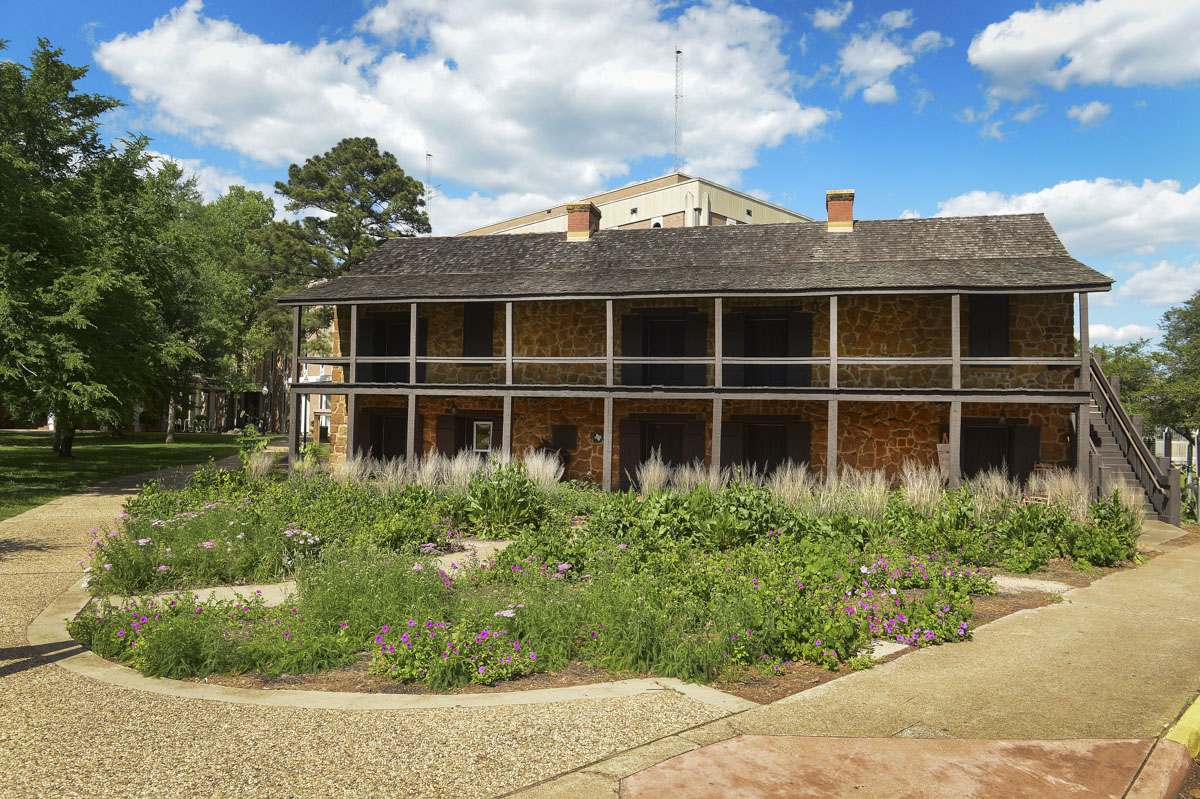A lot can happen in 80 years. The Stone Fort Museum serves as an example. Standing sentinel on the SFA campus since 1936, the museum has played host to many exhibits, speakers and touring groups, while the tide of progress altered the campus that surrounds it.
The Stone Fort Museum is a replica and the second reconstruction of a building originally erected by Antonio Gil Y’Barbo. It began its life as a magnificent Spanish colonial house sometime between 1788 and 1791.
“The Stone Fort Museum is a special place because, as a building, it embodies the multiple stories of Y’Barbo’s house — the memorial building and a Texas Centennial landmark structure — and as a museum, its mission to serve the public and SFA as an educational center connects university resources with local and regional communities,” said museum curator Carolyn Spears, who has worked at the museum for more than 30 years.
“History museums, in general, are places where stories of people, places and change come together. That means to tell the story of East Texas, we cover lots of subjects: technology, science, art, economic and political change, and invention, to name a few. The university community is a great resource for a history museum, and a history museum is a great resource for a university community,” Spears added.
Weathering four revolutionary actions, the home changed hands many times. Eventually, the Mexican government billeted soldiers in the house, and a succession of filibusterers took temporary possession of the building before it settled into its final incarnation as a saloon.
Brothers William and Charles Perkins dismantled the original Stone House in 1902, and the structure’s pieces were donated to the Cum Concilio Club, a women’s study club in Nacogdoches. Some of the original stones were used to construct a building five years later that remained on Nacogdoches public school property for almost 30 years.
Decades later, the structure was dismantled again, and a replica of the original stone trading building was shepherded into existence by the Cum Concilio Club on the Stephen F. Austin State Teachers College campus in honor of the Texas Centennial in 1936.
In 1984, Spears began working at the Stone Fort Museum in the same functional position she holds now. However, over time, she has seen the duties bequeathed to that role greatly expand “as we instituted or updated museum best practices,” she explained.
Linda Reynolds, director of the East Texas Research Center, said Spears is passionate about her profession and the work she does at the Stone Fort Museum. “We have worked together on many different projects. Early in our acquaintance, we digitized many of the museum’s objects and made them available online. Since then, we keep in touch and talk about the changes in our profession, the needs of cultural heritage institutions and our personal lives. I am proud to call Carolyn my colleague and friend.”
Between tours, new exhibits, guest speakers and hands-on activities, it’s hard for Spears to pick a specific favorite memory of her time with the museum.
“I have lots of great memories, most of them tied to people, young and old, who came to learn, to help or to teach,” she said. “I love having college students as employees because they keep me on my toes, and I equally love watching a group of third graders have that ‘whoa’ moment when they enter a room full of artifacts. If I’m honest, I am just as pleased to work in the collection room with objects as my only companions.”
Since Spears began at the museum, the facility has seen major and minor improvements.
“The museum has improved operations in collection management and programming through grant-funded programs, such as the Museum Assessment Program and Conservation Assessment Program,” she said. “Many of the upgrades were made possible as part of the 1990 renovations to the structure. At that time, a rear extension was added to house the office space and a collection storage room. The exterior design of the ‘lean-to’ structure mimics additions made to the original stone house.
“Each project through the years has raised the profile of the museum both locally and nationally. With three national awards for interpretation and state awards for publication design, the museum has made a commitment to excellence that we will build on with the current strategic planning process,” Spears said.
The SFA and Nacogdoches communities celebrated the building’s 80th anniversary in October, exactly eight decades to the day of its dedication in 1936.



